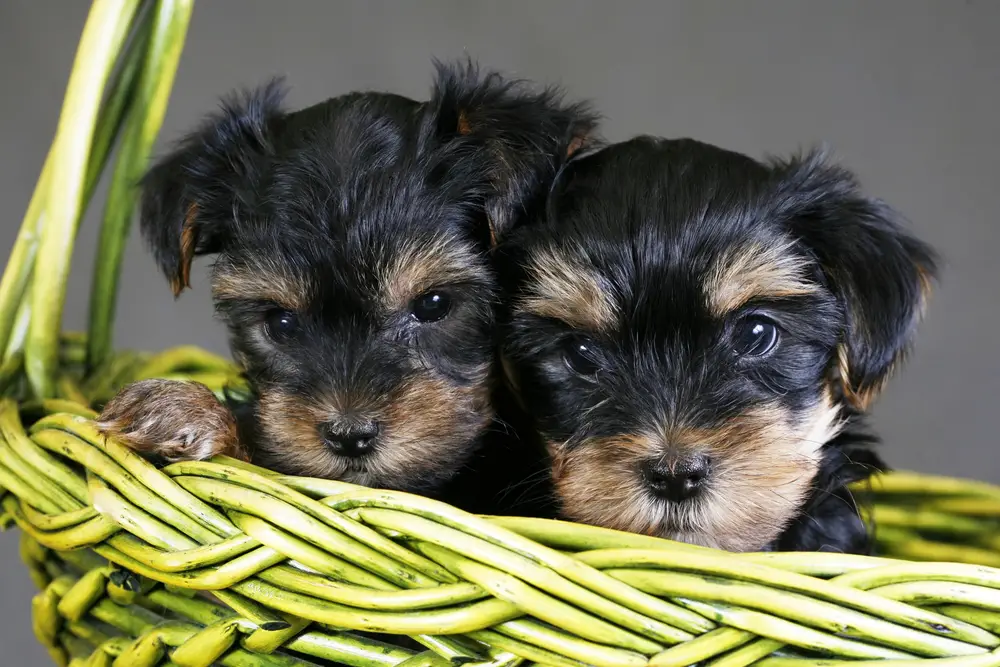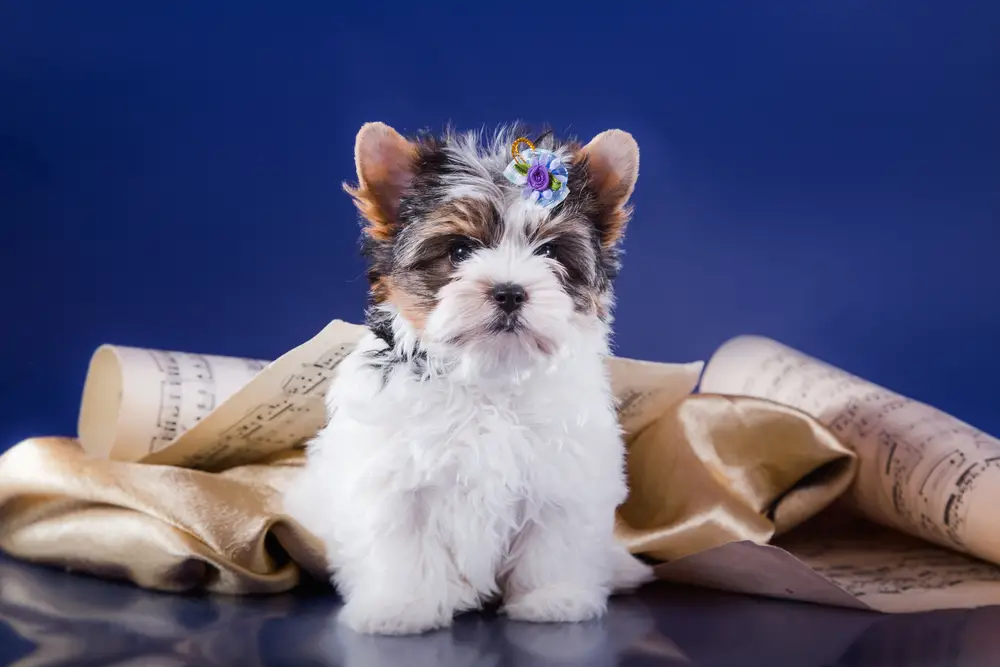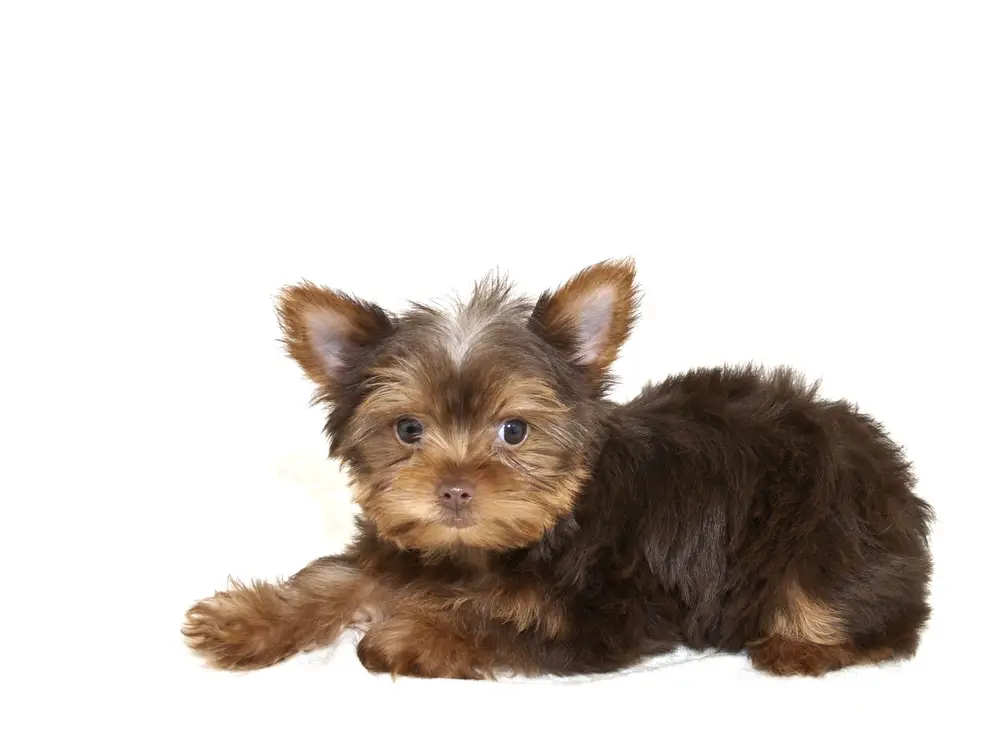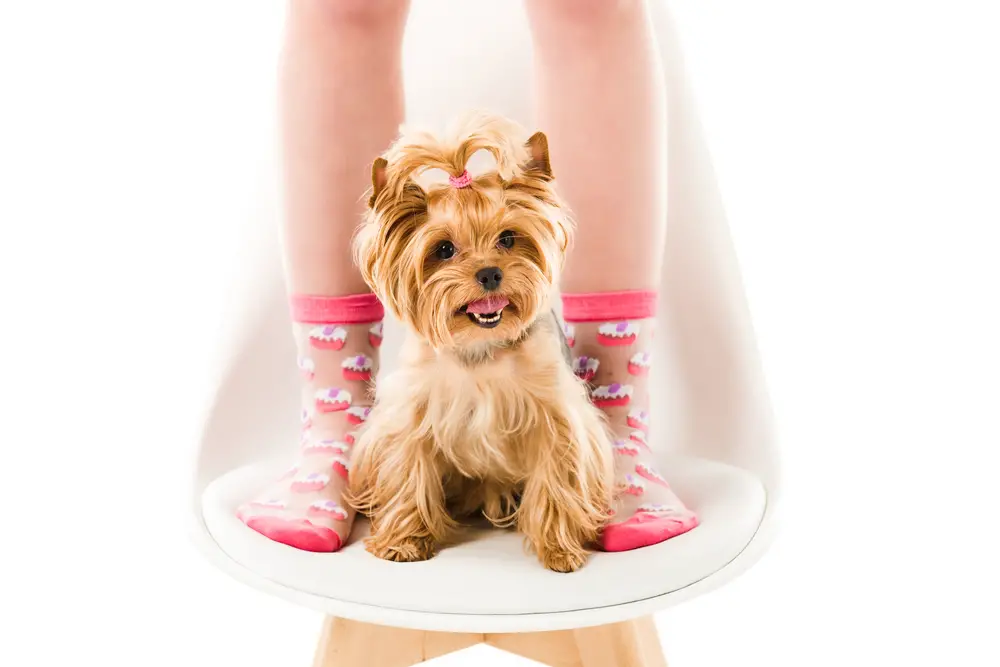Exploring Yorkshire Terrier Coat Colors
The Yorkshire Terrier is a very distinctive breed when it comes to coat color. Unlike most breeds, the color of a Yorkie’s coat can change as it grows from a puppy to an adult. You can also easily recognize a purebred Yorkie based on its color.
Yorkies come in four color combinations: black, blue, gold, and tan. There are also other colors that can appear but they’re very rare. Here’s everything you should know about Yorkie colors, including how they change color as they get older and the classic color of a purebred Yorkshire Terrier.
How Can You Tell if a Yorkie Is Purebred?
Purebred Yorkies are very distinctive because they have genes that cause the dog’s coat to change from black to blue. According to the American Kennel Club, a black and tan Yorkie at birth usually indicates a purebred puppy. The black and tan will intermingle as the puppy matures. To be shown in competition, the blue should be dark blue, not silver blue, and it should be separate and not mixed with black or bronze fur. A purebred Yorkie’s tan hair should be dark at the roots but light at the tips. This gives a purebred Yorkie unique patches of color that don’t mixed.

It’s rare but it is possible for a purebred Yorkie to have very little blue or black. It’s even more rare to see a purebred Yorkie with very little gold or tan shades but also possible.
A Yorkie can still be purebred and registered with the AKC if it falls outside of this standard. The AKC recognizes 5 Yorkie color categories:
— Black and tan Yorkie
— Black and gold Yorkie
— Blue and tan Yorkie
— Blue and gold Yorkie
— Parti — black, tan, and white
Yorkie Puppy Coat Stages
A Yorkie puppy coat is different than an adult coat in terms of color and thickness. Yorkie puppies have a darker coat and what’s known as the black and tan Yorkie or black and brown Yorkie colors with prominent markings. The tan and black markings can vary a great deal, though. Some puppies appear almost solid black with some tan markings, such as strands or tiny patches.
These features fade over the course of two years as the puppy develops its adult coat. You will likely notice your Yorkie’s color changing around the age of 6 months. The color changing process is gradual and it may take anywhere from 1 to 3 years for the process to be complete.
As your Yorkie transitions from a young puppy to an adult, you may see all four common Yorkie colors as the coat changes: the black will be replaced by the blue Yorkie shade and the tan will transition to gold.
Common Yorkie Colors
A Yorkie will have a combination of four common colors:

— Tan
— Gold
— Blue
— Black
The blue Yorkie color doesn’t refer to a literal blue shade; the blue will be a diluted black that may appear to have a blue sheen in the light. In dog breeds, many shades of blue can exist but Yorkies have just one of two blue shades: a dark steel blue or a silver Yorkie shade that looks very shiny.
Yorkies develop this blue color from black thanks to a unique graying gene that affects emulanin production. This is a black Yorkie pigment in the dog’s skin and hair. If the Yorkie has two copies of the gene, they will develop a silver coat as they age. With one copy, they will develop the distinctive dark steel blue coat.
The black and tan Yorkie is typical at birth. As the puppy gets older, the black changes to blue and the tan changes to gold. The gold hair will be darkest at the root and get lighter toward the end.
Here’s an easy way to remember it:
— A black and tan Yorkie is typical as a puppy
— A blue and gold Yorkie is typical as an adult
An adult Yorkie usually has long, gold hair on the head that gets longer on the sides of the hair. The hair is longest at the muzzle and at the ears. This golden color should not go past the neck and it should not have any black or silver hair.
The blue color extends from the Yorkie’s neck to the base of the tail with no visible tan or gold.
The belly, chest, and ears of the Yorkie should be a bright color. The legs will also have golden hair that does not extend past the knees or elbows.
Rare Yorkie Coat Colors
Black, blue, gold, and tan are the common colors for a Yorkie but there are some rare coat colors that can develop.
Red Legged Yorkie
A Red Legged Yorkshire Terrier is a tan and gold Yorkie with a coat that turns a bright red color.

A red legged Yorkie happens due to a throwback gene which means the physical gene expression goes back five generations. A red legged Yorkie had two parents with both copies of a recessive gene.
This rare coat color is interesting because the black Yorkie color will remain instead of changing to blue and the tan will become a deep red color. These Yorkies tend to have a wiry coat with facial hair that grows quite long.
Parti Yorkie
The parti Yorkie is an unusual color combination with the traditional blue Yorkie shade, tan, and white. This coat is caused by a recessive gene.
It’s unknown how the color was introduced to the Yorkshire Terrier. It’s possible the Yorkie was crossbred with the Maltese to improve the coat’s texture allowing Yorkies to produce the recessive white gene.

The AKC now accepts registrations for parti or tri-colored Yorkies thanks to a genetic study on 42 litters, dams, and sires that showed they are purebred Yorkies.
Parti Yorkies have actually existed since the 1800s but they were long considered to be “low quality.” They dogs may have been euthanized or given away discretely so the breeder’s reputation wouldn’t have been destroyed for producing “off-standard” colors.
Parti Yorkies look similar to Biewer Yorkshire Terriers but Biewer Terriers are actually now a separate breed.
In 1984, a Yorkie was born with three distinct colors — white, blue, and gold — and began the offshoot of a separate breed called the Biewer Yorkshire Terrier. The Biewer Terrier is a new terrier breed that was bred in Germany from Yorkshire Terriers. It’s believed the first Biewer Terrier developed its unique coloring because its Yorkie parents had a recessive piebald gene.
If you compare a Biewer Terrier and a parti Yorkie, you will notice a difference in their markings. A parti Yorkie has a tan or gold head with a body that has a mixture of white with black patches. Biewers have a standard color pattern with a white marking across the body.
All Black Yorkie
A purebred Yorkie can be entirely black although it’s rare. In most cases, a black Yorkie is the result of crossbreeding with a black breed and these Yorkies aren’t purebred.
A solid black Yorkie has a dominant gene for the black color and it will probably have one of two characteristics:
— Rigid, rough hair that does not grow to the standard Yorkie length
— Black, dull hair with a thick coat that grows very fast
Chocolate Yorkie

The traditional Yorkie is born with a black coat but a chocolate Yorkie is born all brown. It’s possible some Yorkies carry this recessive gene thanks to crossbreeding with a brown dog like a Dachshund.
A chocolate Yorkie can still be registered with the AKC as a chocolate/tan or liver/tan Yorkie.
Golden Yorkie

Sometimes a Yorkie will be completely gold with no blue tones at all. These Yorkies look almost completely gold or tan with possibly a small streak of blue or black. While puppies, a golden Yorkie may have a solid gold or tan color with white markings. Golden Yorkies can vary a great deal in color with a coat ranging from light blond to a rich gold color.
Blue Born Yorkies
A blue Yorkie will begin as a black Yorkie as a puppy and gradually change color due to their graying gene.
A “blue born Yorkie” happens when the Yorkie has two copies of a recessive gene that make the coat blue at birth.
This is a lethal combination and blue born Yorkies rarely survive. If the puppy does survive to adulthood, it will lose its coat instead of transitioning colors. This will leave the dog virtually hairless with leathery skin.
Yorkie Coat Types
In addition to color variations, Yorkies can also have different types of coats:
— Puppy coat
— Silky coat
— Soft or cotton coat
A Yorkie puppy has a coat that’s softer and thicker than an adult’s coat. This is common for all breeds of puppies.
The AKC standard coat type for a Yorkie is the silky coat. Yorkies actually have hair, not fur, and the desirable coat type is long, straight hair with a glossy sheen. Silky coats require a great deal of grooming and care.
Yorkies can also have a wavy, wire, cotton, or soft coat. Some people think this coat type looks like combed cotton. This type of coat doesn’t brush out smooth and long. It may look wavy, thick, or textured. These coats are usually no more than a few inches long.
Some Yorkies have slightly different coat types. A black Yorkie, for example, was likely crossbred and may have dull, thick hair or rigid hair.
There’s also a link between the color and type of the Yorkie’s coat.
If a Yorkie has a very dark coat, they are unlikely to have a silky coat and it will probably be wavy or soft. if the dog has a light coat, it will probably be the AKC standard silky coat.

